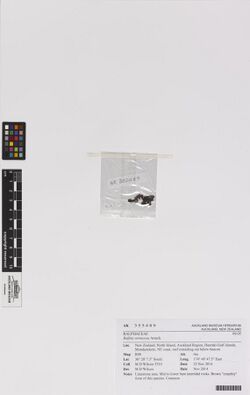Biology:Ralfsia verrucosa
| Ralfsia verrucosa | |
|---|---|

| |
| Ralfsia verrucosa Aresch. | |
| Scientific classification | |
| Domain: | Eukaryota |
| Clade: | Diaphoretickes |
| Clade: | SAR |
| Clade: | Stramenopiles |
| Phylum: | Gyrista |
| Subphylum: | Ochrophytina |
| Class: | Phaeophyceae |
| Order: | Ralfsiales |
| Family: | Ralfsiaceae |
| Genus: | Ralfsia |
| Species: | R. verrucosa
|
| Binomial name | |
| Ralfsia verrucosa Areschoug, 1845[1]
| |
| Synonyms[1] | |
| |
Ralfsia verrucosa is a species of crustose brown seaweed in the family Ralfsiaceae. It grows intertidally in temperate waters around the world. In South Africa it is part of a mutualistic relationship with a limpet.
Description
Ralfsia verrucosa forms roughly circular patches that grow outwards from the centre with the central parts sometimes becoming detached from the substrate. The thallus is deep brown or blackish-brown and is about 1 mm (0.04 in) thick. It has a distinct, often pale-coloured, margin which is formed from erect filaments which are fused together and that curve upwards from other prostrate filaments.[2][3] The patches of thalli are thick, some 2 to 10 cm (1 to 4 in) in diameter and often coalescing to form larger patches. The surface is smooth and hard.[4]
Distribution and habitat
Ralfsia verrucosa is a cosmopolitan species and is found in temperate waters in northern and western Europe, Mediterranean Sea, Iceland, Greenland, Canada, New England, Argentina, round the coasts of Africa, India, Japan, Korea, China, Russia, Indonesia, Australia and New Zealand.[5] It grows on rock in pools in the intertidal zone.[2]
Biology
The brown colour of this seaweed results from the dominance of the xanthophyll fucoxanthin which masks the other pigments that are present, namely chlorophyll a, chlorophyll c, beta-carotene and other xanthophylls.[1] The tissues contain polyphenols which act as a deterrent to herbivores.[3]
Round the coasts of South Africa, Ralfsia verrucosa enjoys a mutual relationship with the limpet Scutellastra longicosta. This limpet clears an area of rock by intensive grazing, and allows Ralfsia verrucosa to settle on it while excluding other species of algae. The limpet then cultivates its "garden", grazing the algal turf to a moderate level and fertilising it with faeces and mucus. A 7 centimetres (2.8 in) limpet can "farm" an area of about 150 square centimetres (23 sq in) of algal turf and defend its territory from intrusion by other limpets.[6]
The genus name commemorates the botanist John Ralfs.[7]
References
- ↑ Jump up to: 1.0 1.1 1.2 Guiry, Michael D. (2013). "Ralfsia verrucosa (Areschoug) Areschoug, 1845". WoRMS. World Register of Marine Species. http://www.marinespecies.org/aphia.php?p=taxdetails&id=145001.
- ↑ Jump up to: 2.0 2.1 Guiry, M. D.. "Ralfsia verrucosa (Areschoug) J. Agardh". The Seaweed Site. http://www.seaweed.ie/descriptions/Ralfsia_verrucosa.php. Retrieved 2013-11-27.
- ↑ Jump up to: 3.0 3.1 Branch, G. M.; Griffiths, C. L.; Branch, M. L.; Beckley, L. E. (2008). Two Oceans: A Guide to the Marine Life of Southern Africa. p. 340. ISBN 9781770076334. https://books.google.com/books?id=W_2QB8ftLgcC&q=Scutellastra+cochlear.
- ↑ "Ralfsia verrucosa Areschoug" (in Spanish). Asturnatura.com. http://www.asturnatura.com/especie/ralfsia-verrucosa.html. Retrieved 2013-11-27.
- ↑ "Ralfsia verrucosa (Areschoug) Areschoug". AlgaeBase. http://www.algaebase.org/search/species/detail/?species_id=305. Retrieved 2013-11-27.
- ↑ "Territoriality in the South African Intertidal Limpet Scutellastra longicosta". http://courses.pbsci.ucsc.edu/eeb/bioe159/wp-content/uploads/2013/06/S.-longicosta-Final-Paper-Amrita-Khalsa-Amanda-Heidt-Victoria-Wade-Shannon-Myers-Travis-Trin_final_edit.pdf. Retrieved 2013-11-29.
- ↑ Burkhardt, Lotte (2022) (in German) (pdf). Eine Enzyklopädie zu eponymischen Pflanzennamen. Berlin: Botanic Garden and Botanical Museum, Freie Universität Berlin. doi:10.3372/epolist2022. ISBN 978-3-946292-41-8. https://doi.org/10.3372/epolist2022. Retrieved January 27, 2022.
Wikidata ☰ Q16988999 entry
 |

